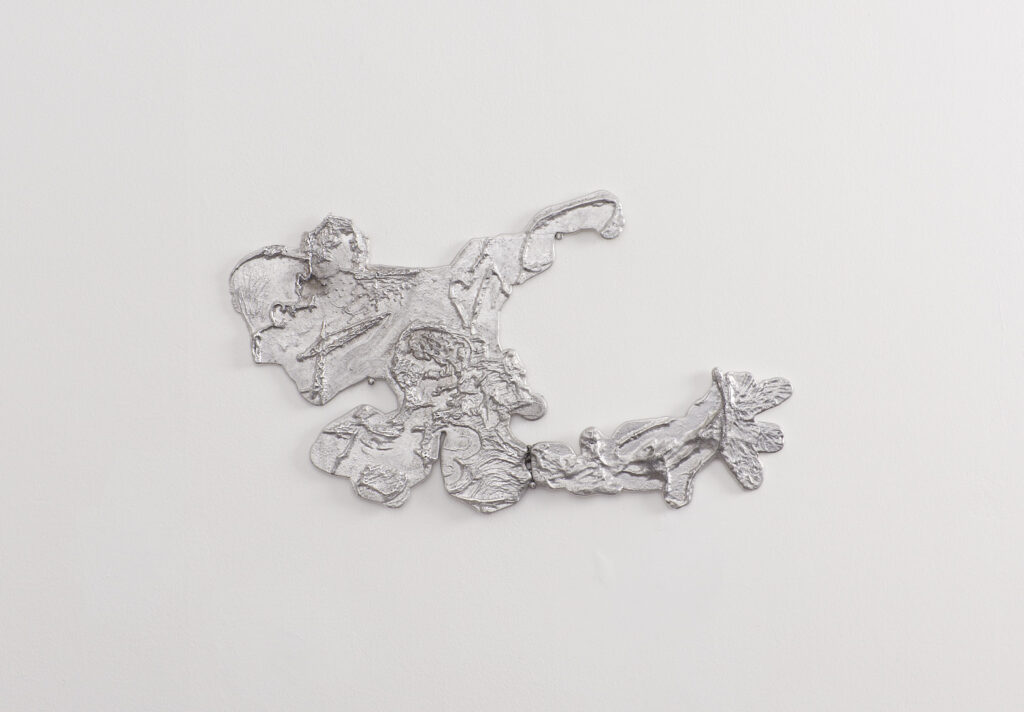Metal Memory, a double solo exhibition by Aliona Ciobanu and Sophia Gatzkan, focuses on the physicality of non-standard bodies and their intellectual secretions, exploring how they both interact with technology to embody narratives of trauma, adaptation and healing. Both artists explore matter as a vehicle for identity and transformation, using it as a starting point to interrogate the socio-cultural and political structures that shape our perceptions of the world. A common theme in their practices is the use of reconfigurative processes, from fusion to assemblage, which allow them to deconstruct and rewrite histories outside of dominant perspectives. Here, memory and metal – understood both as a transformative element and as a vector – meet and become a transformative force. An energy capable of renewing the relational paradigm between contrasting elements and their ability to adapt, creating fluid and nuanced connections.
Aliona Ciobanu’s practice evolves from a study that deconstructs collective memory and political narrative, then redeposits them in a language that overlaps sculpture, writing and sound. She adopts a conversational approach with matter that, through processes of fusion, impression and transformation, releases it from its normative meaning, transforming it into a terrain open to the construction of new narratives. The artist also works with impalpable mediums, layering her material landscapes with field recordings and textual experiments. Her work is articulated as a dialogue between bodies, objects and technologies, in which elements such as USB sticks, keyboards or archive photographs become tools for reflecting on the non-linear construction of contemporary memory. Ciobanu removes ideologically charged objects from their propagandistic function and relocates them in a subjective, organic and imperfect memorial dimension. Her work proposes alternative visions to the sites of collective memory, which are often marked by political dogma, and instead enhances fragmentary – but above all unmediated – stories that come directly from the people. Poor, ordinary, widely used in both domestic and public spheres during the Soviet era, recycled aluminium is central to this discourse: through processes of melting and reshaping, the metal is transformed into a narrative device capable of holding and rewriting stories. This material, steeped in geological and historical memory, becomes the main voice of Ciobanu’s production, which investigates social memory, cultural colonisation and propaganda, drawing on the history and political complexities of her native Moldova.

Sophia Gatzkan’s work addresses the exploration of the human body in relation to non-normative morphologies and the complexities of contemporary identity. Using a language that combines organicity and artifice, the artist interrogates common notions of normality, ability and bodily integrity, proposing a critical reinterpretation of the body and its representation as dimensions of transformation, ambiguity and possibility. Her work is nourished by a dialogue with post-humanist studies, opening up reflections on how the representation of the body is fabricated, mediated and politicised in order to activate a space where fragility and power intertwine in new forms of existence. Her sculptural practice is a hybrid territory in which more or less recognisable portions of the human body merge with objects peeled away from their original function, yet evocative and charged with narrative potential. From these casts of anatomical fragments, Gatzkan seeks figurative ways of staging an encounter between the human and the non-human. Hybrid forms emerge, crossed by the concept of prosthesis, understood as technology capable of amplifying the capabilities of these blended bodies; evanescent, almost spectral figures crystallised in a tension between permanence and precariousness. Elements such as orthopaedic fixators invite caution, while materials such as horn herald slow regeneration; symbols midway on the spectrum between self-defence and violence, leaving the viewer in a state of uncertainty or even apprehension. Despite this apparent immobility, the sculptures are anything but static, becoming theoretical devices that invite us to reconsider bodily experience not as a defined unit, but as a continuum of possibilities and mutations. As in Ciobanu’s work, Gatzkan creates subterranean narratives that speculate on the instability of identity and how it adapts, protects, expands or reinvents itself. To heal, one must first hurt.
Available artworks
Via Rosolino Pilo, 14 – 20129, Milano
Tue–Fri 15.00–19.00
Via Rosolino Pilo, 14 – 20129, Milano
Tuesday – Saturday
11.00–13.00 14.30–19.00
+39 351 328 8223